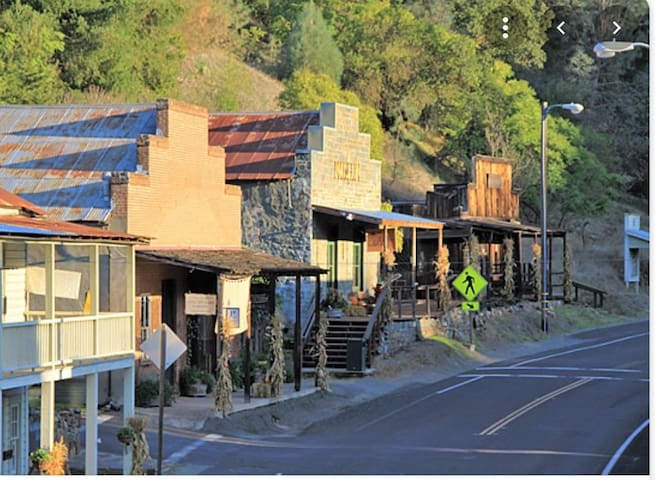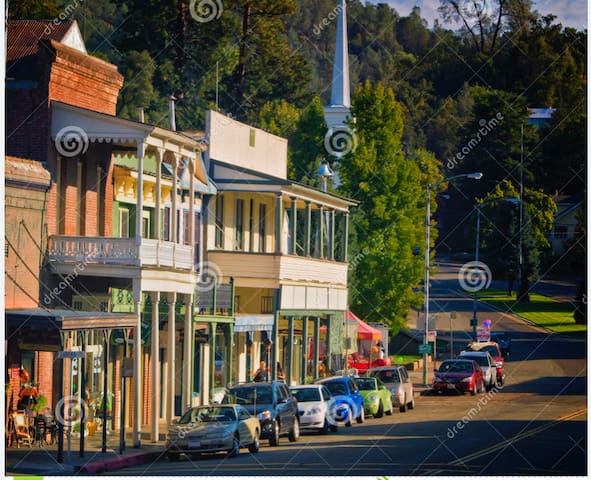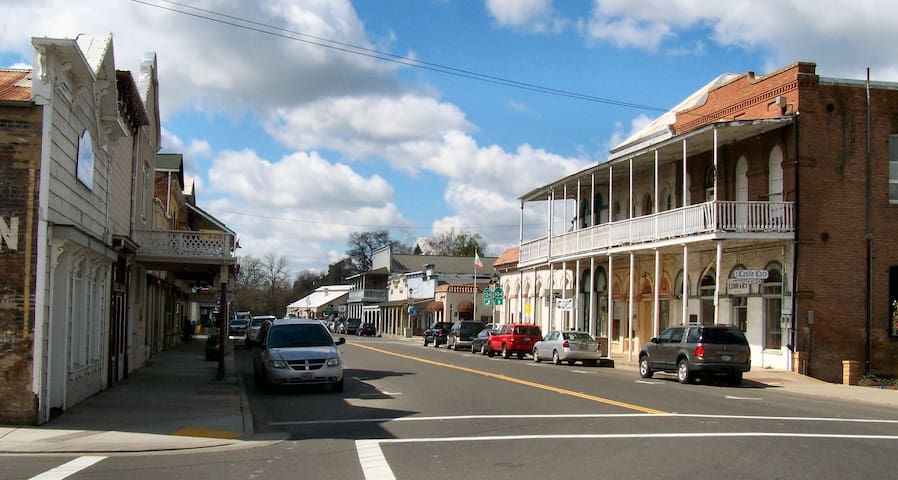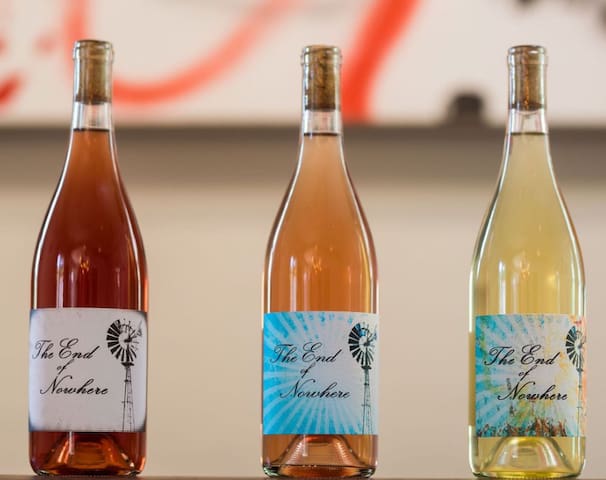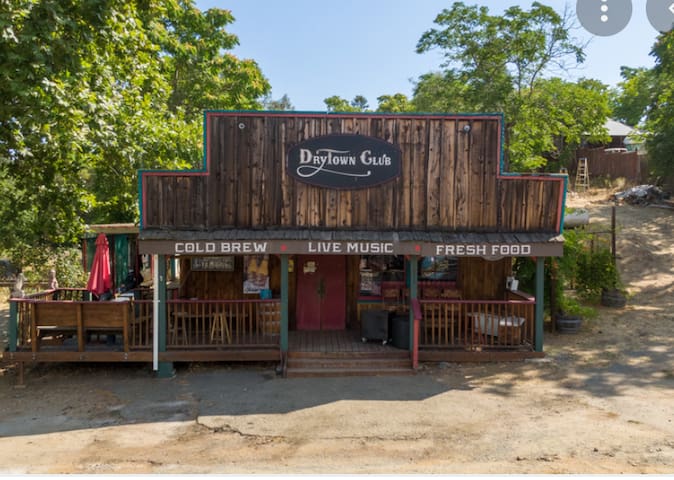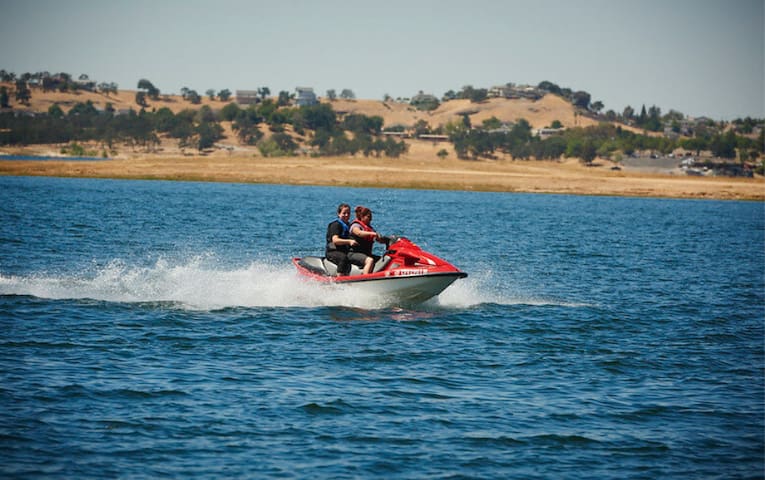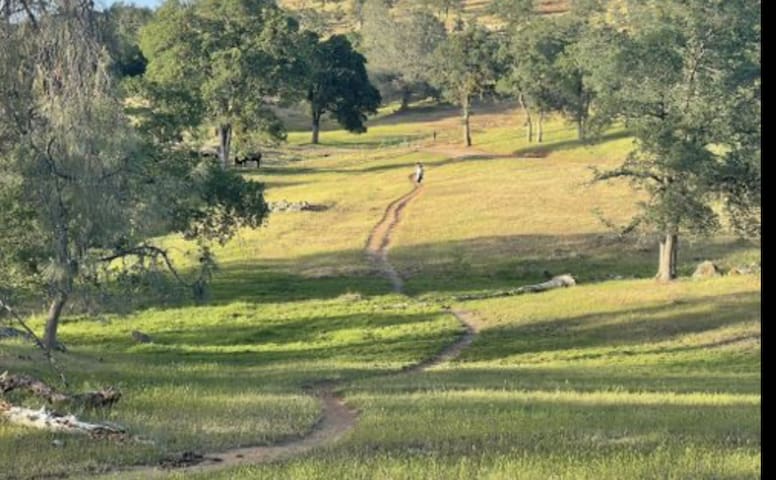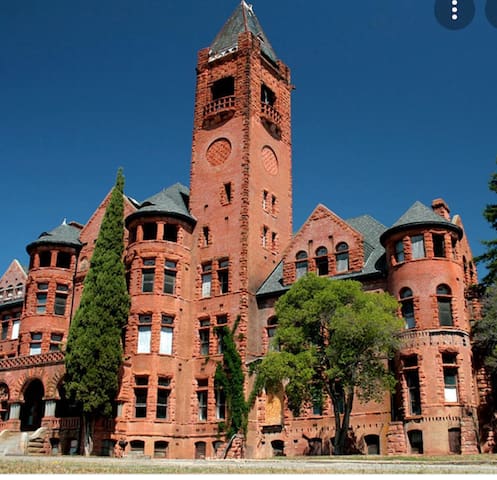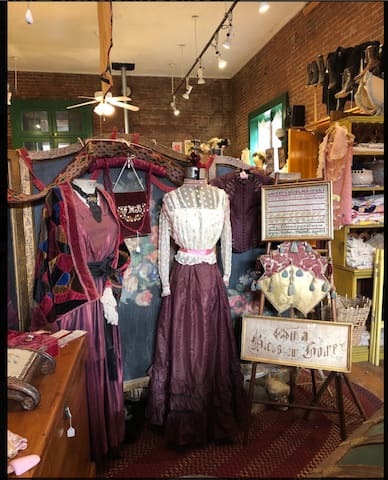City/town information
It all started several hundred yards upstream from today’s town site. Jose Marie Amador, a wealthy California rancher, mined along this nameless creek in 1848-1849. There, gold outcroppings were discovered on both sides of the creek. The Original or Little Amador Mine and the Spring Hill Mine were probably the Country first gold mines. Soon, the creek, the town and a new county carried Amador’s name.
As the “easy” gold was mined out on the upper part of the creek, mining and encampments gradually moved to “South Amadore” where French Gulch flows into the creek. This is the current site of Amador City. The Keystone Mine, organized in 1853, was the city’s most famous gold mine and a major reason why the town grew. In those days there were an estimated four to six thousand residents in Amador City! Before closing in 1942, an estimated $24,000,000 in gold had been mined.
Amador City’s oldest structure, built around 1855, is the center portion of the Amador Hotel. Up Main Street is the stone Fleehart Building (now the Whitney Museum) was the Wells Fargo Building and dates from the 1860’s.
31 persone del luogo consigliano
Amador City
It all started several hundred yards upstream from today’s town site. Jose Marie Amador, a wealthy California rancher, mined along this nameless creek in 1848-1849. There, gold outcroppings were discovered on both sides of the creek. The Original or Little Amador Mine and the Spring Hill Mine were probably the Country first gold mines. Soon, the creek, the town and a new county carried Amador’s name.
As the “easy” gold was mined out on the upper part of the creek, mining and encampments gradually moved to “South Amadore” where French Gulch flows into the creek. This is the current site of Amador City. The Keystone Mine, organized in 1853, was the city’s most famous gold mine and a major reason why the town grew. In those days there were an estimated four to six thousand residents in Amador City! Before closing in 1942, an estimated $24,000,000 in gold had been mined.
Amador City’s oldest structure, built around 1855, is the center portion of the Amador Hotel. Up Main Street is the stone Fleehart Building (now the Whitney Museum) was the Wells Fargo Building and dates from the 1860’s.
The town takes its name from the creek, and the creek takes its name from John A. Sutter. Mr. Sutter owned the saw mill in Coloma where the first “Mother Lode” gold was found in January of 1848. Unable to stop the tide of gold-seekers flowing over and destroying his lands, Sutter decided to follow the call of gold, trying in vain to recoup what the Gold Rush had taken from him. He arrived where Sutter Creek is currently located in 1848 with a band of Kanakas and Indians, and upon finding a likely spot, began mining along the creek.
70 persone del luogo consigliano
Sutter Creek
The town takes its name from the creek, and the creek takes its name from John A. Sutter. Mr. Sutter owned the saw mill in Coloma where the first “Mother Lode” gold was found in January of 1848. Unable to stop the tide of gold-seekers flowing over and destroying his lands, Sutter decided to follow the call of gold, trying in vain to recoup what the Gold Rush had taken from him. He arrived where Sutter Creek is currently located in 1848 with a band of Kanakas and Indians, and upon finding a likely spot, began mining along the creek.
The “Castle City,” Ione offers the perfect blend of small town charm and quality living. Its quaint character and convenient location just 30 miles south east of Sacramento make it the perfect place to work, live, and play. Incorporated in 1953 and located in Amador County the Town comprises 4.7 square miles with a population of approximately 7703. Ione is known for its small-town atmosphere and its outstanding quality of life.
8 persone del luogo consigliano
Ione
The “Castle City,” Ione offers the perfect blend of small town charm and quality living. Its quaint character and convenient location just 30 miles south east of Sacramento make it the perfect place to work, live, and play. Incorporated in 1953 and located in Amador County the Town comprises 4.7 square miles with a population of approximately 7703. Ione is known for its small-town atmosphere and its outstanding quality of life.
Food scene
The End of Nowhere was founded on a simple belief: Wine from great California terroir doesn’t need chemical additives, new oak, or a big price tag to be delicious.
Our founding winemaker, Chris Walsh, didn’t have this epiphany in a vineyard — he had it in a bar. After working as a sommelier in New York City, Chris was ready to trade long nights for a new career and realized his home in Amador County was the perfect place. Thanks to years behind the bar Chris was well-versed in California wine, and as a local he deeply understood the potential of Amador’s rugged, high-elevation terroir.
In June of 2014 he returned to Pioneer to begin planting the 10-acre Little John Lane Estate Vineyard, which surrounds the Walsh family home. From classics like Syrah and Grenache to obscure varieties like Picpoul and Clairette Blanche this site aims to produce Rhône-inspired wines that highlight the unique environment of the foothills, with minimal intervention in the winery.
The End of Nowhere label also showcases grapes grown organically by small farmers in the Sierra Foothills and surrounding appellations.
We are committed to practicing organic farming and treating the land with more than a little love. We live here, and will do whatever it takes to preserve our land for future generations… even if that pulling weeds by hand.
7 persone del luogo consigliano
The End of Nowhere
14204 Main StreetThe End of Nowhere was founded on a simple belief: Wine from great California terroir doesn’t need chemical additives, new oak, or a big price tag to be delicious.
Our founding winemaker, Chris Walsh, didn’t have this epiphany in a vineyard — he had it in a bar. After working as a sommelier in New York City, Chris was ready to trade long nights for a new career and realized his home in Amador County was the perfect place. Thanks to years behind the bar Chris was well-versed in California wine, and as a local he deeply understood the potential of Amador’s rugged, high-elevation terroir.
In June of 2014 he returned to Pioneer to begin planting the 10-acre Little John Lane Estate Vineyard, which surrounds the Walsh family home. From classics like Syrah and Grenache to obscure varieties like Picpoul and Clairette Blanche this site aims to produce Rhône-inspired wines that highlight the unique environment of the foothills, with minimal intervention in the winery.
The End of Nowhere label also showcases grapes grown organically by small farmers in the Sierra Foothills and surrounding appellations.
We are committed to practicing organic farming and treating the land with more than a little love. We live here, and will do whatever it takes to preserve our land for future generations… even if that pulling weeds by hand.
Since Break Even Beermakers got its start nearly three years ago, the project has grown to encompass a taproom, brew house, and small farm where the team plans to grow and harvest fresh hops, stone fruit, and citrus to imbue their beers with the flavor of the Mother Lode region. Beer maker Aaron Wittman says that kind of farm-to-table approach to beer-making is what sets Break Even apart. “It gets back to my philosophy of beer-making: What’s the difference between a beer-maker and a brewer?” asks Wittman, who, although there is no technical difference between the two, considers himself the former. In his view, “it’s being in touch with every aspect of the process. Growing the hops and being able to go out to the fields and see the barley in the fields. There’s not a lot of brewers that get to do that.”
6 persone del luogo consigliano
Break Even Beermakers - Amador City Tavern
14141 Old Route 49Since Break Even Beermakers got its start nearly three years ago, the project has grown to encompass a taproom, brew house, and small farm where the team plans to grow and harvest fresh hops, stone fruit, and citrus to imbue their beers with the flavor of the Mother Lode region. Beer maker Aaron Wittman says that kind of farm-to-table approach to beer-making is what sets Break Even apart. “It gets back to my philosophy of beer-making: What’s the difference between a beer-maker and a brewer?” asks Wittman, who, although there is no technical difference between the two, considers himself the former. In his view, “it’s being in touch with every aspect of the process. Growing the hops and being able to go out to the fields and see the barley in the fields. There’s not a lot of brewers that get to do that.”
Shake Ridge Vineyards is truly a multi-generational effort. The present ‘adult’ generation put in their hours as kids, pulling irrigation hoses, filling smudge pots and picking oranges and avocados on the original family homestead in Corona. When the adventure migrated to Shake Ridge Ranch, even the grandparents came out of retirement to join the endeavor.
The next generation is already earning its stripes. From bottling our homemade wine since they were old enough to take direction, to becoming the best vine workers around, they are a hard working, fun-loving crew. And boy they are smart! Their fresh young minds challenge the old-timers to rethink what’s always been done, giving our methods a fresh approach.
Yorba Wine Tasting
51 Hanford StreetShake Ridge Vineyards is truly a multi-generational effort. The present ‘adult’ generation put in their hours as kids, pulling irrigation hoses, filling smudge pots and picking oranges and avocados on the original family homestead in Corona. When the adventure migrated to Shake Ridge Ranch, even the grandparents came out of retirement to join the endeavor.
The next generation is already earning its stripes. From bottling our homemade wine since they were old enough to take direction, to becoming the best vine workers around, they are a hard working, fun-loving crew. And boy they are smart! Their fresh young minds challenge the old-timers to rethink what’s always been done, giving our methods a fresh approach.
This is a don't miss destination if you like country bread and cinnamon rolls to DIE for!
The Serbian Bakery/Blue Door Bakery
4 North Main StreetThis is a don't miss destination if you like country bread and cinnamon rolls to DIE for!
Feist makes wine from some the finest vineyards in the Sierra foothills. Working with grape growers comitted to excellence and fermenting in small lots Feist produces superior wines of character and quality.
Susan Feist moved to Amador County from Berkeley in 2003. Already interested in wine and immersed in the bay area farm to fork culinary scene Feist quickly became absorbed in food and wine in Amador. After a stint as a GM at a winery in El Dorado county and already full of entrepreunerial spirit she opened Feist Wines.
Along the way music became a big part of the Feist tasting room. They have hosted Grammy award winners and local greats.
Golden Chain Highway
Golden Chain HighwayFeist makes wine from some the finest vineyards in the Sierra foothills. Working with grape growers comitted to excellence and fermenting in small lots Feist produces superior wines of character and quality.
Susan Feist moved to Amador County from Berkeley in 2003. Already interested in wine and immersed in the bay area farm to fork culinary scene Feist quickly became absorbed in food and wine in Amador. After a stint as a GM at a winery in El Dorado county and already full of entrepreunerial spirit she opened Feist Wines.
Along the way music became a big part of the Feist tasting room. They have hosted Grammy award winners and local greats.
Imperial Hotel
14202 Main StreetSightseeing
Lake Camanche is a multi-award winning campground with year-round recreation and fishing. It has 54 miles of shoreline and 7,700 surface acres of water for all your outdoor recreational activities.
The lake features family and group camping by the lake shoreline, cottages, RV sites, hiking, boating, fishing, swimming, equestrian trails and equestrian camping. Lake Camanche is also a popular venue for outdoor weddings, festivals, and corporate events.
Lake Camanche food, lodging, retail and recreation concessions are operated by Basecamp Hospitality to serve the public as authorized by the United States Department of the Interior and the National Park Service.
10 persone del luogo consigliano
Camanche Reservoir
Lake Camanche is a multi-award winning campground with year-round recreation and fishing. It has 54 miles of shoreline and 7,700 surface acres of water for all your outdoor recreational activities.
The lake features family and group camping by the lake shoreline, cottages, RV sites, hiking, boating, fishing, swimming, equestrian trails and equestrian camping. Lake Camanche is also a popular venue for outdoor weddings, festivals, and corporate events.
Lake Camanche food, lodging, retail and recreation concessions are operated by Basecamp Hospitality to serve the public as authorized by the United States Department of the Interior and the National Park Service.
The Wildermuth House is shown in this historic photo with three of the Wildermuth children, from the left, John Andrew, Ada and Isaac. All three were born in the stone home. The Wildermuth House is an excellent example of the stone masonry work of William A. Watt. The home was built for John H. Wildermuth in 1861. Hand-dressed sandstone blocks which were quarried from the hillside nearby were used in the construction. The Wildermuth House is situated near the old Campo Seco Road, which was heavily traveled between the mining centers of Campo Seco and Paloma, site of the famous Gwin Mine.
“It was a home of old-time hospitality, simple, informal and warm. The family life was abundant, sunny, generous, sensible and good–a reflection of the spirit of those who made it.” *
Campo Seco Equestrian Trailhead
Wildermuth House TrailThe Wildermuth House is shown in this historic photo with three of the Wildermuth children, from the left, John Andrew, Ada and Isaac. All three were born in the stone home. The Wildermuth House is an excellent example of the stone masonry work of William A. Watt. The home was built for John H. Wildermuth in 1861. Hand-dressed sandstone blocks which were quarried from the hillside nearby were used in the construction. The Wildermuth House is situated near the old Campo Seco Road, which was heavily traveled between the mining centers of Campo Seco and Paloma, site of the famous Gwin Mine.
“It was a home of old-time hospitality, simple, informal and warm. The family life was abundant, sunny, generous, sensible and good–a reflection of the spirit of those who made it.” *
Preston Castle was constructed in 1894 as the administration building for the Preston School of Industry, a reform school for boys. The Romanesque Revival style of architecture was to make the building look like a school rather than a prison.
The Castle opened in June 1894 and remained in use until 1960. In 1960 the State planned to demolish the building and from 1960-1968 a group of local women fought to keep it standing. Once the State agreed to not tear the building down they also said they would do nothing to keep it standing.
The building remained vacant and in disrepair until September 2001 when the Preston Castle Foundation leased the building from the State. And later, in 2014, the foundation was granted ownership of the Castle and 12.91 acres.
The Preston Castle Foundation’s mission is to preserve, rehabilitate and utilize the historic Preston Castle site as well as preserving the history of the school, its staff and boys.
Today, Preston Castle is open to the public for tours and events. Funds raised are used to restore keep the building standing and hopefully restore it to its original beauty.
Preston School of Industry
900 Palm DrivePreston Castle was constructed in 1894 as the administration building for the Preston School of Industry, a reform school for boys. The Romanesque Revival style of architecture was to make the building look like a school rather than a prison.
The Castle opened in June 1894 and remained in use until 1960. In 1960 the State planned to demolish the building and from 1960-1968 a group of local women fought to keep it standing. Once the State agreed to not tear the building down they also said they would do nothing to keep it standing.
The building remained vacant and in disrepair until September 2001 when the Preston Castle Foundation leased the building from the State. And later, in 2014, the foundation was granted ownership of the Castle and 12.91 acres.
The Preston Castle Foundation’s mission is to preserve, rehabilitate and utilize the historic Preston Castle site as well as preserving the history of the school, its staff and boys.
Today, Preston Castle is open to the public for tours and events. Funds raised are used to restore keep the building standing and hopefully restore it to its original beauty.
Popular activities include picnicking, strolling along trails, fishing for steelhead and salmon, and wading and swimming. This park also affords rafting access to a beautiful stretch of river downstream.
Of special interest is the salmon spawning season, which is generally October through December. During this time, many large adult chinook salmon can be seen returning from the ocean. In November, at the peak of spawning season, hatchery visitors can watch hatchery staff collect eggs. The Mokelumne River Fish Hatchery, operated by the California Department of Fish and Wildlife, is open seven days a week, from 7:00 a.m. to 3:00 p.m. More information is available on the CDFW website.
7 persone del luogo consigliano
Mokelumne River
Popular activities include picnicking, strolling along trails, fishing for steelhead and salmon, and wading and swimming. This park also affords rafting access to a beautiful stretch of river downstream.
Of special interest is the salmon spawning season, which is generally October through December. During this time, many large adult chinook salmon can be seen returning from the ocean. In November, at the peak of spawning season, hatchery visitors can watch hatchery staff collect eggs. The Mokelumne River Fish Hatchery, operated by the California Department of Fish and Wildlife, is open seven days a week, from 7:00 a.m. to 3:00 p.m. More information is available on the CDFW website.
What a perfect location for Sally Knudson's fantastic collection of authentic Victorian era fabrics, clothes and personal adornments. The wonderful vignettes throughout the store certainly gesture back in time to the stores in Amador City, filled with "dry goods." In business in this historic Gold Rush town of Amador County since 1972, Sally holds the notable record for having the longest continually operating business in town.
Her store is filled with such finery that one is immediately transported back to the time of the fancy people of the Gold Rush era. Yes, there may have been a few occasions for the common miner to dress up, but, generally that was not the norm. The finer things shown in Victorian Closet were once only affordable to mine managers and store owners.
Literally, everything that a fine woman might need is in this store! Picture yourself going shopping in the 1880s. You might want a fine quilt for a guest room, a wedding dress for your daughter getting ready to marry a wealthy businessman in Sacramento or San Francisco. Your son needs new shoes and you want your husband to look presentable at the next party. Everything you wanted right here! When you realize that you can select a garment from the distant past, the experience is more exciting.
How did the styles look? Were the clothes comfortable? How long did it take to get dressed? How would fine garments be washed? What would a husband and wife look like on the way to dinner at a fellow mine or successful mercantile owner's home? What style of travel trunks were used? Sally has the answers to these questions and more.
Knowledgeable in fabrics and clothes of this era, she has a notable eye for finding the highest quality available. Buying from England and France as well from U.S. sources, the items that you see in the Victorian Closet show the very best of the best, the intimately personal side of history.
Victorian Closet
14176 Main StreetWhat a perfect location for Sally Knudson's fantastic collection of authentic Victorian era fabrics, clothes and personal adornments. The wonderful vignettes throughout the store certainly gesture back in time to the stores in Amador City, filled with "dry goods." In business in this historic Gold Rush town of Amador County since 1972, Sally holds the notable record for having the longest continually operating business in town.
Her store is filled with such finery that one is immediately transported back to the time of the fancy people of the Gold Rush era. Yes, there may have been a few occasions for the common miner to dress up, but, generally that was not the norm. The finer things shown in Victorian Closet were once only affordable to mine managers and store owners.
Literally, everything that a fine woman might need is in this store! Picture yourself going shopping in the 1880s. You might want a fine quilt for a guest room, a wedding dress for your daughter getting ready to marry a wealthy businessman in Sacramento or San Francisco. Your son needs new shoes and you want your husband to look presentable at the next party. Everything you wanted right here! When you realize that you can select a garment from the distant past, the experience is more exciting.
How did the styles look? Were the clothes comfortable? How long did it take to get dressed? How would fine garments be washed? What would a husband and wife look like on the way to dinner at a fellow mine or successful mercantile owner's home? What style of travel trunks were used? Sally has the answers to these questions and more.
Knowledgeable in fabrics and clothes of this era, she has a notable eye for finding the highest quality available. Buying from England and France as well from U.S. sources, the items that you see in the Victorian Closet show the very best of the best, the intimately personal side of history.
Dreamy Whites Atelier
14171 Main StreetThe best French linens, soaps and pottery. This is a wonderful hidden gem!

